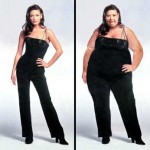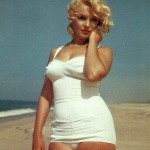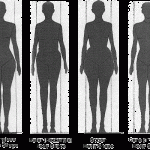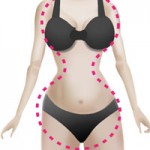Tastes differ and tastes change over time. What was deemed the height of fashion in one era can be the worst of all possible worlds in the next. What better example of this phenomenon than the acceptable shape for a woman? This is one indicator of how fashions have changed in the appearance of a woman, measured in curviness – perhaps as an alternative to skirt length, and arguably much the more interesting measurement.
The 20s and 60s bucked the trend for curvaceous women, but I’d certainly blame the fashion industry in my lifetime for pushing every more anorexic and androgynous girls into being role models for the generation, on the catwalk, in movies, on TV, as pop stars. Suddenly it became fashionable to be skinnier – thin was in! Anorexia and Bulimia were scarcely ever heard of before the 70s but these were psychological illnesses that warped and distorted body image to make those who were painfully thin believe they were grossly obese.
How many mums were shocked by Karen Carpenter‘s death and suddenly began to monitor their own daughter’s eating habits? Self-esteem was measured by healthy girls losing interest in food and losing inches – and damaging their health in the process. But image was suddenly all, and girls came under peer pressure to believe no boy would be remotely interested unless they fitted into size 8 or preferably less. My daughter fits into size 8 jeans but still believes she is fat, and nothing will convince her otherwise – borderline eating disorders are easy to slip into and very hard to escape from. She enjoys food but often starves herself while she is working hard – denying the necessary fuel to study is not a good idea and will only result in detrimental effects on health.
Conversely, there is also the explosion of obesity, notably but far from exclusively an American phenomenon, maybe also partly an effect of comfort eating due to feelings of social inadequacy, and therefore self-perpetuating in a culture where the mythology is rife about happiness and success being synonymous with slender body shape. The medical impacts of overeating are hitting the NHS, to the extent that we have debates on whether or not people who refuse to lose weight should be denied treatment.
Granted there are causes other than psychological to consider. Jobs and lifestyles are far more sedentary, even for women; fattening food is more plentiful and cheaper, to the extent that we have a total reversal on years past – the rich are thinner and the poor fatter.
If you are larger than average (and don’t forget that the average British woman is now size 16), you are less likely to get a good job, people will look down on you and you will be overlooked in many areas of life. People will judge you on that, though in many cases it will be a genetic inheritance over which you have no control that made you the shape you are.
Ironic then that one of the foremost sex symbols of the 20th Century, Marilyn Monroe, was certainly curvy and voluptuous. Arguments rage on forums on precisely what dress size she was, though consensus seems to be that for most of her career she was the equivalent of a UK size 12-14 – but the point is that she had curves.
Whatever the truth of the misuse and abuse of models by the fashion industry in particular (and many have been sent away to lose weight, and a few have suffered with their lives), the fact is that women in their natural state have reserves of fat on breasts, tummy and hips – they have curves and look much the better for an hourglass figure – or any shape that emphasises their curves. Who would want a woman without curves, and why, more to the point? To my eye, and that of many other men, cures are very sexy!
Well it could arguably appeal to a gay aesthetic, and some have argued that the fashion industry is controlled by a “gay mafia” – though I personally find that argument simplistic and assuming culture to be totally saturated and infiltrated by the tastes of fashion. If it were not an existing trend for thin to be desirable among young women, fashion could not exploit it, not to mention the slimming and “healthy eating” brigade, fitness and exercise industries, and more besides.
The usual line is that clothes hang better on very tall, slender models, though if they are to be worn by real women out on the street, it would make far more sense for models to look like real women. Remember how sexy Sophie Dahl looked before the fashionistas had her slim down to look like a skinny waif? What a tragedy that was at a point when a beautiful model was taking a stand for beautiful curves!
This goes way beyond catwalk design, and, as hinted at the start of this blog, will almost certainly change as our culture slowly evolves, as it has done throughout the ages – and the next phase will surely be the cult of the individual – that nobody has to look like anybody else to be desirable.
First thing to be recognised will be that good health does not depend upon being slim, and health can often be ruined by a fixation with body shape. Eat a healthy, balanced diet (ie. no faddy diets, good quality natural ingredients, cooked freshly and eaten in the right combinations to get all the minerals, nutrients, proteins and carbohydrates essential to your lifestyle), exercise regularly, and enjoy your natural shape. In some cases that takes confidence not to feel you are being judged, but the wonderful thing is that if you have talents to display you can be admired for those and suddenly your shape ceases to matter.
By all means lose weight to feel healthier and more comfortable, but don’t be obsessive about it and don’t be pressed into trying to be something you are not – be admired for who you are! Who knows, maybe over time fashion, Hollywood and TV will all change to reflect that not everybody is mega slim, beautiful and conforming to a peripheral view of what ideal bodies should look like.











Well put Andy round of applause